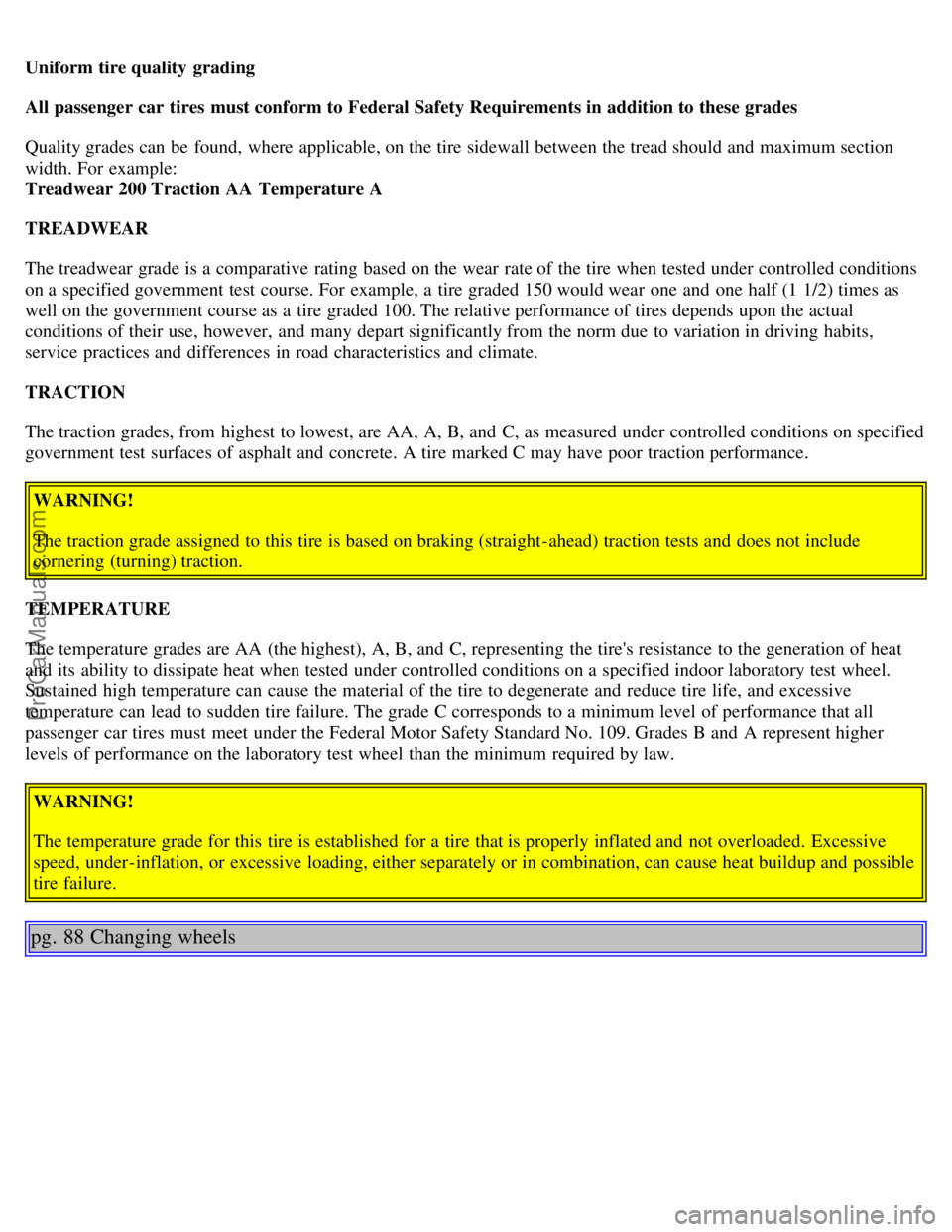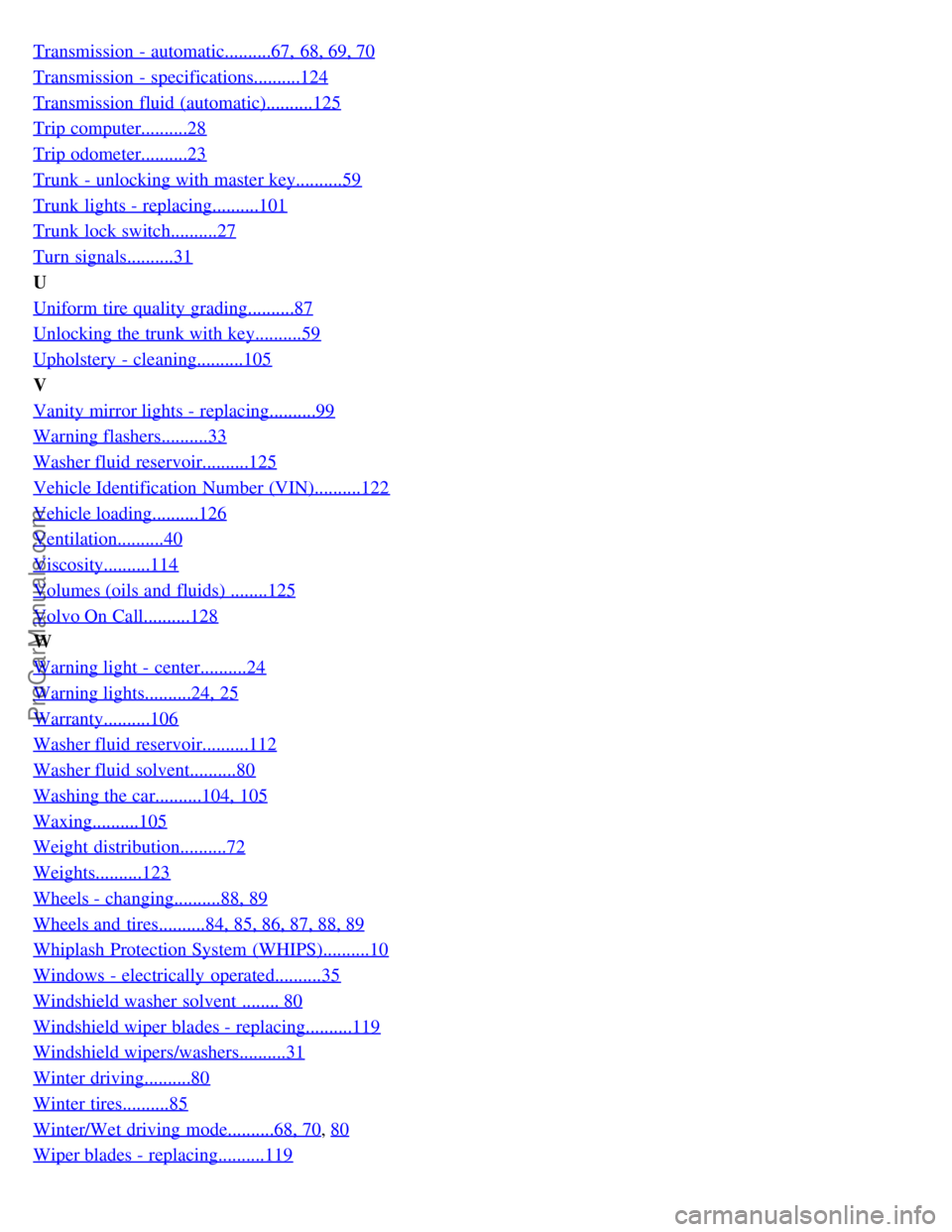2001 VOLVO S80 tires
[x] Cancel search: tiresPage 62 of 106

Uniform tire quality grading
All passenger car tires must conform to Federal Safety Requirements in addition to these grades
Quality grades can be found, where applicable, on the tire sidewall between the tread should and maximum section
width. For example:
Treadwear 200 Traction AA Temperature A
TREADWEAR
The treadwear grade is a comparative rating based on the wear rate of the tire when tested under controlled conditions
on a specified government test course. For example, a tire graded 150 would wear one and one half (1 1/2) times as
well on the government course as a tire graded 100. The relative performance of tires depends upon the actual
conditions of their use, however, and many depart significantly from the norm due to variation in driving habits,
service practices and differences in road characteristics and climate.
TRACTION
The traction grades, from highest to lowest, are AA, A, B, and C, as measured under controlled conditions on specified
government test surfaces of asphalt and concrete. A tire marked C may have poor traction performance.WARNING!
The traction grade assigned to this tire is based on braking (straight-ahead) traction tests and does not include
cornering (turning) traction.
TEMPERATURE
The temperature grades are AA (the highest), A, B, and C, representing the tire's resistance to the generation of heat
and its ability to dissipate heat when tested under controlled conditions on a specified indoor laboratory test wheel.
Sustained high temperature can cause the material of the tire to degenerate and reduce tire life, and excessive
temperature can lead to sudden tire failure. The grade C corresponds to a minimum level of performance that all
passenger car tires must meet under the Federal Motor Safety Standard No. 109. Grades B and A represent higher
levels of performance on the laboratory test wheel than the minimum required by law. WARNING!
The temperature grade for this tire is established for a tire that is properly inflated and not overloaded. Excessive
speed, under-inflation, or excessive loading, either separately or in combination, can cause heat buildup and possible
tire failure.
pg. 88 Changing wheels
ProCarManuals.com
Page 64 of 106

NOTE: To avoid excessive wear and the necessity of rebalancing, mark and reinstall wheels in the same location and
position as before removal. To lessen the chance of imbalance, each wheel hub is equipped with a guide stud to ensure
that a removed wheel can be reinstalled in its original position (as when changing over to winter tires/wheels).
pg. 89 Changing wheels
Installing the wheel
· Clean the contact surfaces on the wheel and hub.
· Lift the wheel and place it on the hub. Make sure that you align the wheel with the guide stud on the wheel hub prior
to installation.
· Install the wheel bolts and tighten handtight. use the lug wrench, tighten crosswise(see illustration above) until all
bolts are snug.
· Lower the vehicle to the ground and alternately tighten the bolts crosswise to 100 ft. lbs. (136 Nm).
· Install the wheel cap (where applicable).WARNING!
· The jack must correctly engage the bar in the jack attachment (A). The car's weight must not rest on the jack
attachment (B). See illustration on page 88
.
· Be sure the jack is on a firm, level, non-slippery surface.
· Never allow any part of your body to be extended under a car supported by a jack.
· Use the jack intended for the car when replacing a wheel. For any other job, use stands to support the side of the
car being worked on.
· Apply the parking brake and put the gear selector in the (P)ark position.
· Block the wheels standing on the ground, use rigid wooden blocks or large stones.
· The jack should be kept well-greased.
CAUTION:
· The car must not be driven with wheels of different dimensions or with a spare tire other than the one that came with
the car. The use of different size wheels can seriously damage your car's transmission.
ProCarManuals.com
Page 83 of 106

The spark plugs should be changed every 30,000 miles (48,000 km). However, city driving or fast highway driving
may necessitate changing after 15,000 miles (24,000 km) of driving. When installing new plugs, be sure to fit the right
type and use correct torque. When changing the plugs, check that the suppressor connectors are in good condition.
Cracked or damaged connectors should be replaced. When changing the spark plugs, clean the terminals and the
rubber seals.WARNING!
The distributor ignition system operates at very high voltages. Special safety precautions must be followed to
prevent injury. Always turn the ignition off when:
· Replacing distributor ignition components e.g. plugs, coil, etc.
· Do not touch any part of the distributor ignition system while the engine is running. This may result in unintended
movements and body injury.
Front suspension
Spring strut suspension with integrated shock absorbers and control arms linked to the support frame. Powerassisted
rack and pinion steering. Safety type steering column.
The alignment specifications apply to an unladen car but include fuel, coolant and spare wheel.
Toe-in measured on the wheel rims: 2.3 mm +/ 0.8 mm
Toe-in measured on tire sides: 2.8 +/ 0.9 mm
Rear suspension
Individual rear wheel suspension with longitudinal support arms, double link arms and track rods.
Toe-in measured on the tire sides: 1.9 mm +/ 1.9 mm
Vehicle loading
The tires on your Volvo should perform to specifications at all normal loads when inflated as recommended on the tire
information label. The label is located on the inside of the fuel tank cover. The label lists both tire and vehicle design
limits. Do not load your car beyond the load limits indicated. WARNING!
Improperly inflated tires will reduce tire life, adversely affect vehicle handling and can possibly lead to failure
resulting in loss of vehicle control without prior warning.
All specifications are subject to change without prior notice.
pg.127 Electrical system
Electrical system
12 Volt, negative ground.
ProCarManuals.com
Page 104 of 106

Side direction indicator - replacing..........99
Side impact airbag system (SIPS)..........8
Side marker lights - replacing..........101
Sideview mirrors..........36
Sideview mirrors - folding ........27
Sideview mirrors - heated..........33
Sideview mirrors - memory function..........36
Snow chains..........85
Snow tires..........85
Spare tire.......... 53, 86
Spark plugs..........126
Specifications..........124
Speed -sensitive power steering..........72
SRS..........6
SRS diagnostic system..........24
Stability Traction Control (STC)..........18, 27
Start inhibitor (immobilizer)..........56, 66
Starting the engine..........66
Steering wheel adjustment ........ 32
Steering wheel lock..........32
Storage compartment in center console..........52
Storage compartments..........51
Studded tires..........85
Sun blinds..........38
Sun roof..........37
Supplemental Restraint System..........4, 24
Suspension..........126
Switches in center console ........ 27
T
Tachometer..........23
Tail light bulbs - replacing ........ 98
Temperature gauge..........23
Temporary spare tire..........86
Text window..........26
Three-way catalytic converters..........82
Tire pressure..........86
Tires..........72, 84, 85, 86, 87
Tires - changing..........88, 89
Tool bag..........53
Towing a trailer..........76
Towing eyelet..........74
Towing the car..........74, 75
Trailer towing..........76
Trailer weight - maximum..........123
ProCarManuals.com
Page 105 of 106

Transmission - automatic..........67, 68, 69, 70
Transmission - specifications..........124
Transmission fluid (automatic)..........125
Trip computer..........28
Trip odometer..........23
Trunk - unlocking with master key..........59
Trunk lights - replacing..........101
Trunk lock switch..........27
Turn signals..........31
U
Uniform tire quality grading..........87
Unlocking the trunk with key..........59
Upholstery - cleaning..........105
V
Vanity mirror lights - replacing..........99
Warning flashers..........33
Washer fluid reservoir..........125
Vehicle Identification Number (VIN)..........122
Vehicle loading..........126
Ventilation..........40
Viscosity..........114
Volumes (oils and fluids) ........125
Volvo On Call..........128
W
Warning light - center..........24
Warning lights..........24, 25
Warranty..........106
Washer fluid reservoir..........112
Washer fluid solvent..........80
Washing the car..........104, 105
Waxing..........105
Weight distribution..........72
Weights..........123
Wheels - changing..........88, 89
Wheels and tires..........84, 85, 86, 87, 88, 89
Whiplash Protection System (WHIPS)..........10
Windows - electrically operated..........35
Windshield washer solvent ........ 80
Windshield wiper blades - replacing..........119
Windshield wipers/washers..........31
Winter driving..........80
Winter tires..........85
Winter/Wet driving mode..........68, 70, 80
Wiper blades - replacing..........119
ProCarManuals.com